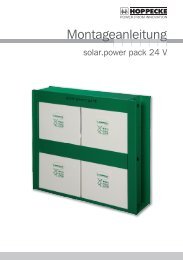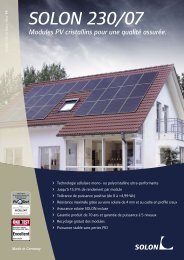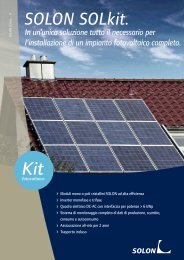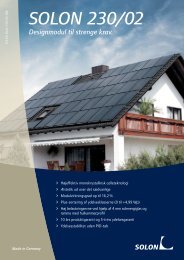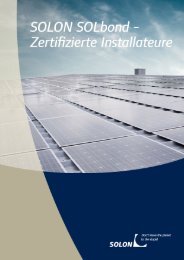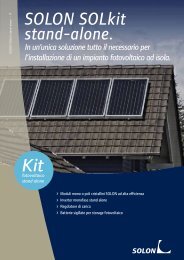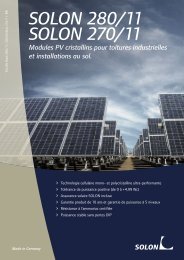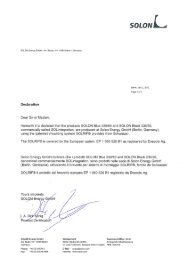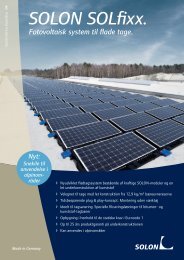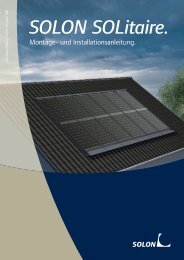mechanical stability of solar cells within solar panels - Solon
mechanical stability of solar cells within solar panels - Solon
mechanical stability of solar cells within solar panels - Solon
You also want an ePaper? Increase the reach of your titles
YUMPU automatically turns print PDFs into web optimized ePapers that Google loves.
MECHANICAL STABILITY OF SOLAR CELLS WITHIN SOLAR PANELS<br />
S. Pingel, Y. Zemen, O. Frank, T. Geipel and J. Berghold<br />
SOLON SE, Am Studio 16, 12489 Berlin, Germany<br />
Tel.: +49 30 81879-0, Fax: +49 30 81879-9999, Sebastian.Pingel@solon.com<br />
ABSTRACT: The PV market is still expanding causing the situation in PV industry becoming more and more<br />
complex. Different cell types emerge on the market provided by a growing number <strong>of</strong> cell suppliers. Due to silicon<br />
shortage in the past <strong>solar</strong> <strong>cells</strong> were getting significantly thinner <strong>within</strong> the past few years. All these parameters have<br />
a potential impact on the <strong>mechanical</strong> <strong>stability</strong> <strong>of</strong> a <strong>solar</strong> panel. This paper focuses on the dependency <strong>of</strong> the<br />
<strong>mechanical</strong> <strong>stability</strong> <strong>of</strong> <strong>solar</strong> <strong>cells</strong> <strong>within</strong> a <strong>solar</strong> panel on different factors as cell thickness, cell interconnection<br />
technology and cell supplier. Test procedures concerning the <strong>mechanical</strong> <strong>stability</strong> <strong>of</strong> <strong>solar</strong> <strong>panels</strong> were carried out<br />
according to industry standards and beyond. For detailed evaluation <strong>of</strong> the <strong>panels</strong> suitable analysis methods as IV<br />
curves and electroluminescence images were utilized. Beside other observations discussed in this paper it has been<br />
found that the <strong>mechanical</strong> <strong>stability</strong> <strong>of</strong> <strong>solar</strong> <strong>cells</strong> <strong>within</strong> a <strong>solar</strong> panel is significantly reduced with decreasing cell<br />
thickness. Referring to this result the rapid thickness reduction on wafer level going on in PV industry needs to be<br />
investigated closely. Solar cell processes and the module manufacturing need to be adapted.<br />
Keywords: Stability, Degradation, PV Module<br />
1 INTRODUCTION<br />
In the past years the PV industry worked hard on<br />
decreasing costs for <strong>solar</strong> <strong>cells</strong> and <strong>panels</strong>. Wafer costs<br />
account for a big part <strong>of</strong> the costs for the end product.<br />
Hence reducing the costs for the wafer is a good strategy<br />
for reducing the final costs. A common approach is the<br />
increase <strong>of</strong> the overall yield by reducing the wafer<br />
thickness. However thickness reduction without<br />
consequent adapting <strong>of</strong> all process steps in subsequent<br />
processing leads to a lower breakage force on cell level<br />
and thereby to increasing breakage rates and decreasing<br />
<strong>mechanical</strong> <strong>stability</strong> <strong>of</strong> the <strong>solar</strong> panel.<br />
Why is cell <strong>stability</strong> in a panel an important issue?<br />
Depending on the grade <strong>of</strong> cell breakage the output<br />
power can be reduced. If parts <strong>of</strong> the cell are electrically<br />
isolated the active cell area is reduced and the resulting<br />
current mismatch might cause the cell operating in<br />
reverse bias and bearing an increased hot spot risk due to<br />
higher current densities. Accordingly, <strong>mechanical</strong><br />
<strong>stability</strong> <strong>of</strong> <strong>solar</strong> <strong>cells</strong> <strong>within</strong> the panel influences both<br />
potential power degradation and reliability <strong>of</strong> a PV panel.<br />
In this paper we present an investigation <strong>of</strong> the<br />
influence <strong>of</strong> the wafer thickness on the cell stress and the<br />
resulting <strong>mechanical</strong> <strong>stability</strong> <strong>within</strong> a <strong>solar</strong> panel. The<br />
studied wafer thicknesses are ranging from 160µm to<br />
270µm. Asides from wafer quality and thickness also the<br />
handling in general and the cell processing affects the<br />
<strong>stability</strong> <strong>of</strong> a <strong>solar</strong> cell. We show two examples where<br />
cell process optimization results in an improved <strong>stability</strong><br />
<strong>of</strong> the <strong>cells</strong> <strong>within</strong> the panel.<br />
Furthermore the panel manufacturing has an<br />
influence on the <strong>mechanical</strong> <strong>stability</strong> <strong>of</strong> the product.<br />
Process parameters and kind <strong>of</strong> interconnection<br />
technology impact the interaction <strong>of</strong> cell and ribbon.<br />
Different thermal expansion coefficient (CTE) <strong>of</strong> cell and<br />
ribbon lead to stress in the cell during soldering. To<br />
reduce this stress is the main objective <strong>of</strong> a panel<br />
manufacturer.<br />
A bunch <strong>of</strong> other factors influence the <strong>mechanical</strong><br />
<strong>stability</strong> as well for example glass thickness, panel<br />
geometry and frame. Here we focus on the influence <strong>of</strong><br />
ribbon geometry and alternative interconnection methods<br />
on the <strong>mechanical</strong> <strong>stability</strong> <strong>of</strong> the <strong>solar</strong> panel.<br />
How is the <strong>mechanical</strong> <strong>stability</strong> tested?<br />
The common PV standard IEC 61215 [1] includes only a<br />
static <strong>mechanical</strong> load test with 2400Pa respective<br />
5400Pa in the extended test version. This pressure is<br />
applied to simulate snow loads.<br />
Since these standard is not covering all <strong>mechanical</strong><br />
loads a panel is facing in reality [2] <strong>Solon</strong> has introduced<br />
a test procedure for the evaluation <strong>of</strong> the <strong>mechanical</strong><br />
<strong>stability</strong> including also a dynamic load tests (shaker test)<br />
simulating for example transportation and other dynamic<br />
loads. This test meets the transportation standard in DIN<br />
EN60068 [3]. Evaluation <strong>of</strong> degradation due to cell<br />
breakage is done by STC flash testing and<br />
electroluminescence (EL) images. Prior and after every<br />
test step a panel is measured. In a first step a panel is<br />
tested with the shaker and afterwards this stressed panel<br />
is placed in the climatic chamber and tested according to<br />
IEC 61215. Power degradation as well as breakage rate is<br />
determined. To evaluate the <strong>solar</strong> cell <strong>stability</strong> without<br />
the influence <strong>of</strong> the panel production the <strong>cells</strong> are tested<br />
with a so called twist tester as described in the following<br />
section.
2 EXPERIMENTAL<br />
2.1 Twist test for investigating on cell level<br />
To evaluate <strong>mechanical</strong> <strong>stability</strong> <strong>of</strong> <strong>solar</strong> <strong>cells</strong><br />
without the influence <strong>of</strong> the interconnection and<br />
lamination processes an <strong>of</strong>fline twist tester is used.<br />
Details <strong>of</strong> this test are described in [4]; a picture <strong>of</strong><br />
replication is shown in fig. 1. The <strong>solar</strong> cell is supported<br />
in two edges along the diagonal. An increasing force is<br />
applied on the two other edges until the cell breaks.<br />
Maximum bending and breakage force are measured.<br />
Figure 1: Twist tester setup.<br />
2.2 Dynamic load test for <strong>panels</strong><br />
To simulate <strong>mechanical</strong> stress that <strong>panels</strong> may<br />
experience during their lifetime a so called shaker is an<br />
appropriate setup. The excitation <strong>of</strong> the specimen is in a<br />
broad frequency range where frequencies occur<br />
randomly. The shaker utilized at <strong>Solon</strong>, see fig. 2, from<br />
LDS is capable <strong>of</strong> simulating transportation in the broad<br />
frequency band from 5 to 500Hz. The resonance<br />
frequency <strong>of</strong> a panel is in the range <strong>of</strong> 10-15Hz which is<br />
part <strong>of</strong> the excitation spectrum. Testing is carried out<br />
according to the transportation standard part <strong>of</strong><br />
DIN EN60068.<br />
Figure 2: Shaker setup.<br />
Other established <strong>mechanical</strong> load tests that are<br />
named in common PV standards IEC 61215 usually work<br />
with static loads (2400Pa/5400Pa). Static or single<br />
frequency loads do not cover naturally occurring multi<br />
frequency loads from wind or transportation. Material<br />
fatigue can be tested in an appropriate time if a load is<br />
applied with a higher frequency, as done with the shaker.<br />
2.3 Evaluation <strong>of</strong> the <strong>mechanical</strong> damage<br />
In this study all <strong>panels</strong> are evaluated with an<br />
electroluminescence (EL) image taken with a high<br />
resolution CCD camera. To weight power loss due to<br />
<strong>mechanical</strong> stress the power <strong>of</strong> the <strong>panels</strong> is measured<br />
before and after each test with a common flasher.<br />
Concerning power degradation the grade <strong>of</strong> cell<br />
breakage can be investigated with the EL method: Two<br />
extremes can be distinguished: (a) micro cracks that do<br />
not change the performance <strong>of</strong> a cell and (b) further<br />
propagated and expanded cracks that lead to isolation <strong>of</strong><br />
parts <strong>of</strong> a single cell. This isolation creates loss <strong>of</strong> power<br />
due to lower cell short circuit current or an increase in<br />
series resistance. During <strong>mechanical</strong> or thermal stress a<br />
crack <strong>of</strong> type (a) can propagate to type (b) as shown in<br />
fig. 3.<br />
Figure 3: EL image <strong>of</strong> a cell initial (left) after shaker<br />
(middle) and after TC400 (right). Clearly visible is the<br />
origin and evolution <strong>of</strong> cracks because <strong>of</strong> <strong>mechanical</strong> and<br />
further growth due to thermal stress.<br />
The breakage rate <strong>of</strong> a panel is determined by simply<br />
counting the number <strong>of</strong> <strong>cells</strong> showing cracks or breakage<br />
and dividing this by the number <strong>of</strong> <strong>cells</strong> in the panel. This<br />
rate neglects classification <strong>of</strong> breakage but the degree <strong>of</strong><br />
damage is indicated by the power degradation.<br />
3 EXPERIMENTAL RESULTS<br />
3.1 Wafer thickness dependence<br />
Cells made from acidic (160, 180, 200 and 220µm)<br />
and alkaline textured (270µm) wafers by one <strong>of</strong> <strong>Solon</strong>’s<br />
suppliers were used to build framed 60 cell <strong>panels</strong>. Every<br />
group <strong>of</strong> <strong>panels</strong> (4-8 <strong>panels</strong> per group) was tested with<br />
the shaker. For each group <strong>of</strong> <strong>panels</strong> and every cell<br />
position in the panel the average breakage rate is shown<br />
in fig. 4. Cells located closer to the aluminum frame<br />
show less damage. Clearly visible is the large damage for<br />
160 and 180µm after the shaker test.<br />
Figure 4: Average spatially resolved breakage rate for 60<br />
<strong>cells</strong> <strong>panels</strong> made from <strong>cells</strong> with varying thicknesses<br />
after shaker test.
Aside from counting broken <strong>cells</strong> the power <strong>of</strong> the <strong>panels</strong><br />
was re-measured after the test. Results <strong>of</strong> breakage rate<br />
and power degradation are shown in Fig. 5.<br />
Figure 5: Average breakage rate depending on wafer<br />
thickness before and after shaker test. Values for power<br />
degradation are also noted.<br />
Both the number <strong>of</strong> broken <strong>cells</strong> and the power loss<br />
clearly increase with decreasing wafer thickness. The<br />
power loss in the field can be higher, because only<br />
<strong>mechanical</strong> stress was applied in this experiment.<br />
Deviations may be explained on cell side by large<br />
tolerances in wafer thickness (usually specified are<br />
variations up to 20%) and quality but also the cell process<br />
has a large influence on the <strong>mechanical</strong> strength as will<br />
be shown below. The impact <strong>of</strong> wafer thickness and<br />
manufacturing process effects the cell <strong>stability</strong> as<br />
investigated in [4]. Especially the texturization as well as<br />
printing and firing <strong>of</strong> the Al paste play an important role.<br />
Soldering and lamination process have a large influence<br />
on the <strong>stability</strong> <strong>of</strong> the cell in the panel compound.<br />
As shown here thinner <strong>cells</strong> are more likely to break<br />
although they are more flexible in the twist test. But as<br />
will be shown in the next sections there is room for<br />
improvement on cell and panel level.<br />
3.3 Influence <strong>of</strong> cell process on <strong>stability</strong><br />
The shaker test became an essential part <strong>of</strong> the cell<br />
release process. For example first tests with one <strong>of</strong> our<br />
mono suppliers using 200µm wafers showed a breakage<br />
rate <strong>of</strong> up to 60% (fig. 6). This rate is not acceptable<br />
concerning long term reliability in the field.<br />
This experiment shows that not alone thickness<br />
affects the <strong>mechanical</strong> <strong>stability</strong> <strong>of</strong> a cell but the whole<br />
cell process has a large impact.<br />
With these results the cell supplier analyzed their cell<br />
process concerning <strong>mechanical</strong> stress and optimized the<br />
process. New <strong>cells</strong> were delivered and tested again. The<br />
breakage rate dropped to below 10%. See figures 6 and 7<br />
before and after process optimization.<br />
Figure 6: Panel EL image before (top) and after (bottom)<br />
<strong>mechanical</strong> load test before optimization <strong>of</strong> the mono<br />
crystalline <strong>cells</strong>.<br />
Figure 7: Panel EL image before (top) and after (bottom)<br />
<strong>mechanical</strong> load test <strong>of</strong> the optimized mono <strong>cells</strong>.<br />
Optimized and not optimized <strong>cells</strong> from this supplier<br />
were compared with the twist test. A significant increase<br />
in breakage force <strong>of</strong> about 7% was found. The internal<br />
stress or pre damage <strong>of</strong> the cell must have been reduced.<br />
This indication supports the results <strong>of</strong> the <strong>mechanical</strong><br />
load test on panel level. Another important result <strong>of</strong> this<br />
investigation: simply using thick wafers or <strong>cells</strong> for<br />
<strong>panels</strong> is no good assurance for good reliability.
As shown in the section about the thickness dependence,<br />
thin <strong>cells</strong> are more likely to break but there is the<br />
potential to reduce overall costs. Nowadays panel<br />
manufacturer are facing <strong>solar</strong> cell thickness as low as<br />
160µm. Initial tests at <strong>Solon</strong> with these <strong>cells</strong> showed low<br />
<strong>stability</strong> and a breakage rate <strong>of</strong> almost 40% and a power<br />
degradation <strong>of</strong> 1.9% after <strong>mechanical</strong> load and TC200,<br />
see fig. 9.<br />
Figure 8: EL image <strong>of</strong> panel with 160µm <strong>cells</strong> (II run)<br />
before test sequence (top) and after shaker and TC400<br />
(bottom).<br />
After several test runs and significant adaption <strong>within</strong><br />
the cell process later batches <strong>of</strong> 160µm test <strong>cells</strong> showed<br />
promising results. Further process optimizations lead to<br />
stable power during the shaker test and low degradation<br />
in thermal cycling (TC) with 200 cycles (
Figure 11: Mono and multi crystalline cell supplier<br />
comparison in breakage rate after shaker test.<br />
The power degradation in the supplier comparison<br />
was always below 2% after shaker test and the maximum<br />
degradation found after the following TC200 was 2.5%<br />
compared to the initial power.<br />
3.5 Ribbon thickness variation and alternative<br />
interconnection technique<br />
During the soldering process stress is introduced in<br />
the cell because high temperature is needed to form a<br />
stable electric contact between busbar and ribbon. Solar<br />
cell and ribbon have different CTEs and thereby during<br />
the cool down <strong>of</strong> the string the cell gets stressed.<br />
One way to reduce this stress is to solder at lower<br />
temperatures while good adhesion must be guaranteed<br />
another way is to use a more flexible ribbon. Thinner<br />
ribbons reduce the stress introduced in the cell as well.<br />
Concerning power degradation and influence on the<br />
<strong>mechanical</strong> <strong>stability</strong> different ribbon thicknesses and<br />
alternative interconnection techniques were compared.<br />
Besides conventional soldering <strong>mechanical</strong> clamping and<br />
gluing with electrical conductive adhesive (ECA) was<br />
investigated. The results <strong>of</strong> power measurement and<br />
breakage rate are shown in fig. 12.<br />
Figure 12: Breakage rate <strong>of</strong> two <strong>panels</strong> soldered with<br />
different ribbon thicknesses (blue and orange) and two<br />
<strong>panels</strong> made with non soldering techniques - <strong>mechanical</strong><br />
clamping (green) and ECA (black). Above the data points<br />
is noted the relative power degradation.<br />
In the case <strong>of</strong> <strong>mechanical</strong> clamping all <strong>cells</strong> survive the<br />
<strong>mechanical</strong> load test without any breakage. Compared to<br />
this glued and soldered <strong>cells</strong> show higher breakage rates<br />
<strong>of</strong> ~2% for ECA and the thinner ribbon and 15% for the<br />
thicker ribbon after shaker test. After the following<br />
TC200 breakage rate rose a bit for the soldered <strong>panels</strong>.<br />
Looking at the power degradation the impression is<br />
contrary. Soldering shows only negligible power<br />
degradation while ECA has a little higher as noted in<br />
fig. 12. The clamped panel degrades by extreme 6.8%<br />
because the electric contact is not stable during thermal<br />
expansion and contraction. Table I summarizes the<br />
results <strong>of</strong> this investigation.<br />
Table I: Comparison <strong>of</strong> interconnection techniques<br />
Ribbon<br />
Interconnection<br />
Clamped Soldered Glued<br />
Long term<br />
<strong>stability</strong><br />
- + +<br />
Mechanical<br />
<strong>stability</strong><br />
+ 0 +<br />
This experiments shows that soldering does induce stress<br />
to the cell which increases if thicker ribbons are used. In<br />
terms <strong>of</strong> long term reliability soldering is more stable<br />
than clamping as interconnection technique. The use <strong>of</strong><br />
ECA could be an interesting compromise between higher<br />
power degradation compared to soldering but with less<br />
<strong>mechanical</strong> stress. Ribbon thickness can be adapted to<br />
reduce the stress introduced in <strong>cells</strong> during soldering. In<br />
the end this is a question <strong>of</strong> minimizing the overall costs<br />
keeping in mind the higher encapsulation losses for<br />
thinner ribbons.<br />
4 CONCLUSION<br />
Wafer thickness reduction leads to higher sensitivity<br />
<strong>of</strong> the <strong>solar</strong> cell to <strong>mechanical</strong> loads. For further<br />
decreasing <strong>of</strong> wafer thickness all following process steps<br />
<strong>within</strong> the value chain have to be carefully adapted in the<br />
cell production as well as the panel production. As shown<br />
for <strong>cells</strong> made from 160µm wafers it is possible to build<br />
stable <strong>panels</strong> provided the internal stress is reduced on<br />
cell and panel level. Therefore all processes <strong>within</strong> the<br />
value chain need to be optimized concerning <strong>mechanical</strong><br />
<strong>stability</strong>. On panel production side it was shown that the<br />
stress introduced by the soldering process can be<br />
significantly reduced by the usage <strong>of</strong> optimized ribbon or<br />
alternative interconnection techniques like ECA.<br />
All these process optimizations for <strong>solar</strong> <strong>cells</strong> are the<br />
key for panel reliability and a lifetime <strong>of</strong> 25+ years.<br />
5 REFERENCES<br />
[1] IEC 61215 “Crystalline Silicon Terrestrial<br />
Photovoltaic Modules – Design Qualification and<br />
Type Approval” edition 2 (2005)<br />
[2] Wohlgemuth, J. H., "The effect <strong>of</strong> cell thickness on<br />
module reliability“33rd IEEE PVSC (2008)<br />
[3] IEC 60068-2-64 “Environmental testing - Part 2-64:<br />
Tests - Test Fh: Vibration, broadband random and<br />
guidance” edition 2 (2008)<br />
[4] Schneider, A., PHD Thesis, University <strong>of</strong> Konstanz<br />
(2004)




